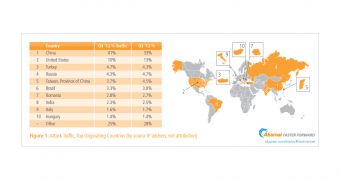According to Akamai’s “State of the Internet” report for the fourth quarter of 2012, last year, the number of distributed denial-of-service (DDOS) attacks increased by 200% compared to 2011.
Of the 768 attacks reported by 413 Akamai customers, 35% targeted organizations from the commerce sector, 22% were aimed at media and entertainment firms, and 20% were launched at enterprise companies.
14% of the attacks targeted high-tech companies and 9% targeted public sector agencies.
As far as the DDOS attacks launched by Izz ad-Din al-Qassam Cyber Fighters are concerned, in the second phase of Operation Ababil, they continued to leverage the BroBot botnet. Their attacks varied in an attempt to evade filtering.
The BroBot botnet has been observed as being capable of sending up to 18 million requests per second, so it’s no wonder the websites of the targeted financial institutions haven’t been able to fend off the attacks.
When it comes to cyberattacks in general, most of them originated in China. However, the fact that 41% of attack traffic was traced to China doesn’t necessarily mean the attackers reside in the country.
That’s because an attacker based elsewhere could have utilized compromised computers in China to carry out the cyberattacks.
The list of countries where most of the attack traffic originated is completed by the US, Turkey, Russia, Taiwan, Brazil, Romania, India, Italy and Hungary.
“Looking back across the year, we observed strong growth in our key connectivity metrics around the world. We believe that this points to greater availability of broadband connectivity, as well as increased speeds on those connections,” said Akamai’s David Belson.
“This is supported as well by the long-term trends observed over the five-year history of the State of the Internet Report. The combination of improved broadband availability and higher speeds should open the door for greater innovation in how the Internet is used by both businesses and individuals around the globe.”
The complete report is available here

 14 DAY TRIAL //
14 DAY TRIAL //